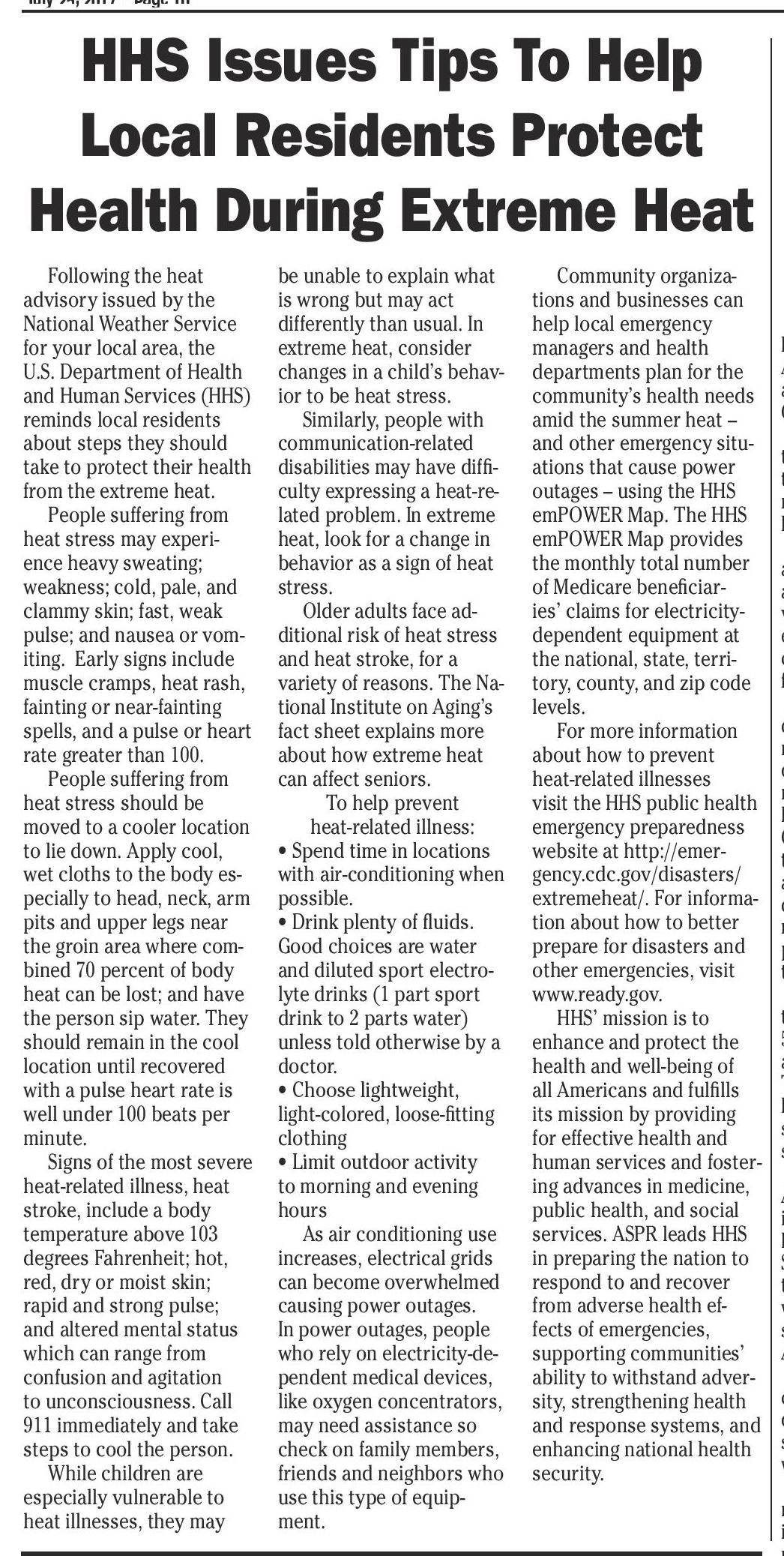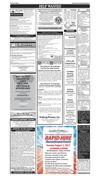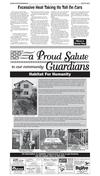072517_YKMV_A10.pdf









July 25, 2017 • Page 10
shop online at www.missourivalleyshopper.com
SD National Guard Artillery
HHS Issues Tips To Help
Unit Trains In Romania During
Local Residents Protect
Saber Guardian
Health During Extreme Heat
Following the heat
advisory issued by the
National Weather Service
for your local area, the
U.S. Department of Health
and Human Services (HHS)
reminds local residents
about steps they should
take to protect their health
from the extreme heat.
People suffering from
heat stress may experience heavy sweating;
weakness; cold, pale, and
clammy skin; fast, weak
pulse; and nausea or vomiting. Early signs include
muscle cramps, heat rash,
fainting or near-fainting
spells, and a pulse or heart
rate greater than 100.
People suffering from
heat stress should be
moved to a cooler location
to lie down. Apply cool,
wet cloths to the body especially to head, neck, arm
pits and upper legs near
the groin area where combined 70 percent of body
heat can be lost; and have
the person sip water. They
should remain in the cool
location until recovered
with a pulse heart rate is
well under 100 beats per
minute.
Signs of the most severe
heat-related illness, heat
stroke, include a body
temperature above 103
degrees Fahrenheit; hot,
red, dry or moist skin;
rapid and strong pulse;
and altered mental status
which can range from
confusion and agitation
to unconsciousness. Call
911 immediately and take
steps to cool the person.
While children are
especially vulnerable to
heat illnesses, they may
be unable to explain what
is wrong but may act
differently than usual. In
extreme heat, consider
changes in a child’s behavior to be heat stress.
Similarly, people with
communication-related
disabilities may have difficulty expressing a heat-related problem. In extreme
heat, look for a change in
behavior as a sign of heat
stress.
Older adults face additional risk of heat stress
and heat stroke, for a
variety of reasons. The National Institute on Aging’s
fact sheet explains more
about how extreme heat
can affect seniors.
To help prevent
heat-related illness:
• Spend time in locations
with air-conditioning when
possible.
• Drink plenty of fluids.
Good choices are water
and diluted sport electrolyte drinks (1 part sport
drink to 2 parts water)
unless told otherwise by a
doctor.
• Choose lightweight,
light-colored, loose-fitting
clothing
• Limit outdoor activity
to morning and evening
hours
As air conditioning use
increases, electrical grids
can become overwhelmed
causing power outages.
In power outages, people
who rely on electricity-dependent medical devices,
like oxygen concentrators,
may need assistance so
check on family members,
friends and neighbors who
use this type of equipment.
Community organizations and businesses can
help local emergency
managers and health
departments plan for the
community’s health needs
amid the summer heat –
and other emergency situations that cause power
outages – using the HHS
emPOWER Map. The HHS
emPOWER Map provides
the monthly total number
of Medicare beneficiaries’ claims for electricitydependent equipment at
the national, state, territory, county, and zip code
levels.
For more information
about how to prevent
heat-related illnesses
visit the HHS public health
emergency preparedness
website at http://emergency.cdc.gov/disasters/
extremeheat/. For information about how to better
prepare for disasters and
other emergencies, visit
www.ready.gov.
HHS’ mission is to
enhance and protect the
health and well-being of
all Americans and fulfills
its mission by providing
for effective health and
human services and fostering advances in medicine,
public health, and social
services. ASPR leads HHS
in preparing the nation to
respond to and recover
from adverse health effects of emergencies,
supporting communities’
ability to withstand adversity, strengthening health
and response systems, and
enhancing national health
security.
MV Shopper
CLASSIFIEDS
M I S S O U R I VA L L E Y
IN PRINT & ONLINE
The Town
To place your ad call...
605.665.5884
By Staff Sgt. Rachel Korzeniewski
129th Mobile Public Affairs Detachment
CINCU, Romania - Soldiers of South
Dakota Army National Guard's 1-147th Field
Artillery Battalion trained alongside U.S. and
allied nation forces during the exercise Saber
Guardian 17 in Romania, July 2-18.
About 110 Soldiers from the battalion
trained on their operational capabilities, battlefield integration and fire support coordination with U.S. Army, National Guard and
Romanian forces.
SG17, a U.S. Army Europe-led, multinational exercise, takes place in Bulgaria, Hungary
and Romania with approximately 25,000 service members from 22 partner nations. The
exercise highlights participant deterrence
capabilities, specifically the ability to mass
forces at any given time anywhere in Europe.
"Our mission for Saber Guardian was to
deploy to Romania and show our commitment to our NATO allies for our common
defense," said Lt. Col. Paul Hollenack, commander, 5th Battalion, 113th Field Artillery
Regiment, North Carolina Army National
Guard. "We want to show our interoperability
through a fire support coordination exercise
and a combined arms live-fire exercise that
demonstrates how we can integrate maneuver, air and artillery forces from various
partner nations into concentrated effects on
the battlefield."
While participating in SG17, Alpha Battery, 1-147th FA was assigned under the
5-113th Field Artillery Battalion and 1st Cavalry Division Artillery of Fort Hood, Texas.
The battery operates the M270A1 Multiple
Launch Rocket System, which can fire 12
surface-to-surface rockets in fewer than 60
seconds.
"We are working with 1st Cavalry Division
Artillery, the main division in the Army,
in conjunction with 5-113th Field Artillery
Battalion, a High Mobility Artillery Rocket
System unit, to learn the different capabilities and similarities of each other's launchers
while conducting field artillery operations,"
said Staff Sgt. Nicholas Tyler, launcher chief,
Alpha Battery.
"The 1-147th brought a new and different
capability," said Hollenack. "Being from a
different state, they also brought a new perspective on training and how they operate,
which we were all able to learn from."
The exercise gave the units an idea in
many ways what it's like to deploy and fight
in a foreign country. Going overseas brings
new obstacles for units, such as learning new
terrain and increased planning and preparation compared to utilizing the same training
area year after year.
"If you look at the fundamental tasks we
trained in, they weren't much different, but
we fundamentally changed the conditions
in which we operated and that really challenged us in our processes and systems - that
is where the learning comes," said Hollenack.
The 1st Cav. DIVARTY provides fire support coordination and mission command for
the training and readiness of field artillery
units participating in SG17.
"Falling under division artillery and
having them generate the pace of the fire
missions we were executing was a new
challenge and a growing event for us," said
Capt. Brandon Jarman, commander of Alpha
Battery, 1-147th FA. "The live-fire exercise
ys
y Da
Craz
we participated in was a joint-fire mission
alongside multiple nations and active duty
components - integrating tube artillery and
aviation assets is a piece we do not normally
get to exercise."
Tyler said the exercise gave the unit more
of an idea on what to expect the next time
they're in a similar situation; for example,
coming up with ways to keep the launchers
cool during down time and better sleep plans
for the crewmembers.
"The most unique aspect about this
training is the field time. We normally do
not spend this much time in the field," said
Tyler. "The weather has been a challenge,
it changes very quickly here and we've had
rain storms come through in a matter of 10
minutes. That's something we do not see at
home."
Training alongside allied nations has also
created opportunities the units wouldn't
normally have.
"In any exercise or event, you are always
coordinating with the units to your left
and your right," said Hollenack. "With the
Romanian 83rd Larom Battalion being on
our right flank, we have had a lot of direct
coordination with deconflicting terrain where
U.S. forces are on the battlefield, as well as
sharing space for our fire direction center,
sharing resources, sharing ambulances and
doing combined medevac exercises. That is
where our main interaction with Romania
comes from in this exercise."
Part of this training exercise was for
NATO and U.S. forces to work together and
build relationships.
"Watching the Romanian Laroms fire and
conduct their crew drills helped build that
relationship and trust," said Jarman. "It was
nice to see that their tactics, techniques, procedures and operations are not that different
from ours."
For the live-fire missions to be successful,
the unit needed support from numerous sections. Each component went through their
own obstacles to ensure the fire missions
were a success.
"The most critical component the unit
has is our maintenance section," said Tyler.
"Without them, we wouldn't be able to
complete our missions, and they'll work day
and night to ensure our launchers are ready.
Communication and the support staff are
also key parts in making sure we are successful."
Fire direction crews had a few hurdles of
their own to jump through during this year's
annual training.
"A challenge as a fire direction chief is coordinating fire," said Staff Sgt. Jesse Holman,
fire direction chief, Alpha Battery, 1-147th FA.
"We had close air and maneuver elements
in our area of operations, overcoming these
challenges gave us an opportunity to train in
a realistic scenario."
Jarman said he wanted the unit to concentrate on certain tasks such as survivability,
movability and communication - aspects of
field artillery that tend to take a backseat to
live-fire missions.
"A lot of the credit goes to our guys that
have been out in the field working hard," said
Tyler. "This mission was successful because
of all the time and effort the lower enlisted
and non-commissioned officers put in. They
did a great job out here."
Meridian District
Saturday, July 29
Craz y
% CRAZY DAYS | July 29, 2017
ood Up To 5v0 tory
G
als! Select In en• Saturday
De
riday
Thursday • F he Best Deals!
For T
Shop Early
219 W. 3rd St. • 260-8362
Rita’s
Purse–o–Nalities
CRAZY DAY SALE
Starts NOW!
Shop Inside Where It’s Cool!!
5 & $10 Racks
$
30% OFF
ALL MEN’S & WOMEN’S SANDALS
Lisa’s Fashions
15-50% DISCOUNTS STORE-WIDE
Mon., July 24 through Sat., July 29
Visit our website to see our huge selection of furniture:
www.davidsdepotsales.com
Hours: Monday-Friday 10 a.m.-7 p.m., Saturdays 10 a.m.-5 p.m., Closed Sundays
Discover Downtown and Yankton Crazy Days!
CRAZY DAYS SALE
ONE DAY ONLY!
Flooring, Mattresses & Accessories
In-Store Specials ~ Open 9-5pm
PLUS MORE CRAZY DEALS
boston
shoes to boots
footwear experts since 1915
312 W 3RD STREET
YANKTON, SD
605.665.9092
1 Day Only!
Making Room For New Fall Inventory!
25 Off
%
Select
Furniture
Plus Many Sale Items In Store!
Register To Win A $50 Gift Card!
106 W. 3rd, Downtown Yankton • 605-665-8691
107 W. 4th, Yankton • 605-689-3016
209 W. 3rd St., Yankton • 605.668.0622
109 East Third, Yankton
605.665.4416 • 800.798.4663
Monday-Friday 10-6, Saturday 10-5,
Closed Sundays, Evenings by Appt
www.hatchfurniture.com
MS
SELECT ITE
ay Pricing
Crazy D
t Selection!
arly For Bes
Shop E
turday
Friday & Sa
108 W. 3rd St., Downtown Yankton • 665-2599






















 Previous Page
Previous Page





